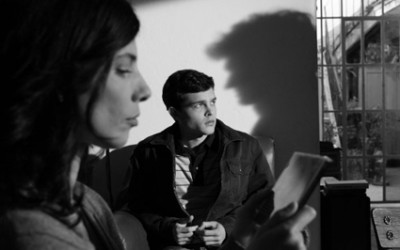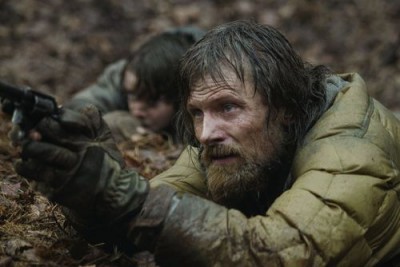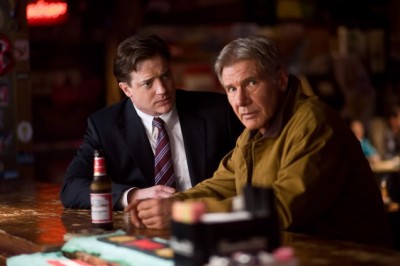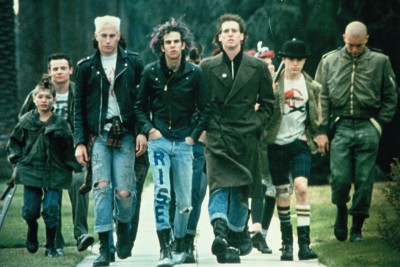Jean-Pierre Jeunet's new film Micmacs (Micmacs à tire-larigot) reflects a very French love of clowns, mimes, and circus folk. It is a whimsical concoction that returns to the visually inventive style that Jeunet is known for. The filmmaker's predilection for mute losers and homemade machinery is on full display, as is his sense of humor, which favors the silent-film set-ups of Buster Keaton and Harold Lloyd. But despite all of this, Micmacs doesn't work. Its themes are murky and generic. Worse than that, the characters are one-dimensional; instead of backgrounds and revealing dialogue, they are only provided with funny costumes and acrobatic challenges. There is a flatness about the entire venture that makes the film simultaneously cartoonish and dull.
In a short prologue, we see a French solider being blown up by a landmine he is trying to defuse. This man's son, Bazil (Dany Boon), grows up to be a shiftless video store clerk who lags through life watching old mysteries and sucking soft cheeses out of their foil wrappers. One night, there is a gunfight outside in the street and a stray bullet lodges itself in Bazil's skull. Its placement is too hazardous for surgeons to attempt a removal, and Bazil must live out his days with the knowledge that the bullet could, at any moment, spontaneously complete its journey toward his brain.
From this dark, fable-like opening, we are taken straight into Jeunet-ville, as Bazil takes up with a ragtag bunch of rejects who live in a gigantic, hollowed-out trash heap. Led by Placard (Jean-Pierre Marielle), this band of misfits cannibalizes salvaged goods to create inventive new machinery and tools. Bazil channels their collective genius to serve his own purpose: to bring down the two mega-corporations who manufactured, respectively, the landmine that killed his father and the bullet lodged in his own head. This effort propels the bulk of the film, as the team stages a series of pranks and gags designed to pit the two corporate CEOs against one another.
The film's original French title roughly translates as "nonstop shenanigans." That is a fair enough characterization of the film, and it's incredible that the American distributor of the picture chose to stick with Micmacs, since it's a highly idiomatic French word that signifies nothing to the average American viewer.
"Nonstop shenanigans" though the film may be, Jeunet's visual flourishes and imaginative stunts don't add up to much. The whimsical flair of Amelie and the truly inventive momentum of Delicatessen are limply revisited, but without the essential inspiring spark of ingenuity that made those previous films memorable. There is no central guiding logic or purpose behind Micmacs, neither from a visual or character point of view. Instead, a very thin revenge story is carried out in a monotonous series of episodes that pile heavy-handed "satire" on top of some very well-worn jokes and situations.
The trouble here, I think, is the combination of the light, vibrant, playful style that Jeunet excels at, and the darker subject matter of the revenge story - a revenge that is ultimately neutered of any real danger or consequence. Jeunet's approach does not gel with the deadly impact of the arms industry that we see at the picture's start - Bazil's injury and his father's death. The stakes are uneven; comedy can hardly trump deadly force, can it? On some level, Benigni's Life is Beautiful suffers from the same quandary, although ultimately that film is far less tasteful than Jeunet's. Still, style and content seem mismatched in Micmacs - it's a juxtaposition that never seems quite comfortable.
The performances are capable. Boon is an energetic clown who works hard to bring the picture to life. His antics seem occasionally arbitrary, as does the film as a whole. Truly charming, however, is Julie Ferrier as La Môme Caoutchouc, a contortionist member of the gang who develops a romantic attachment to Bazil. She has the most development of any character in the film, and her slowly increasing regard for the "lost boy" Bazil is tenderly convincing.
Micmacs has its charm, but that charm is limited by a lack of depth, both in terms of character-based substance and thematic material. There is satire here, somewhere, but it's buried beneath the enormous weight of Jeunet's dependence upon visual flourishes and the increasingly annoying buffoonery of its cast.
In a short prologue, we see a French solider being blown up by a landmine he is trying to defuse. This man's son, Bazil (Dany Boon), grows up to be a shiftless video store clerk who lags through life watching old mysteries and sucking soft cheeses out of their foil wrappers. One night, there is a gunfight outside in the street and a stray bullet lodges itself in Bazil's skull. Its placement is too hazardous for surgeons to attempt a removal, and Bazil must live out his days with the knowledge that the bullet could, at any moment, spontaneously complete its journey toward his brain.
From this dark, fable-like opening, we are taken straight into Jeunet-ville, as Bazil takes up with a ragtag bunch of rejects who live in a gigantic, hollowed-out trash heap. Led by Placard (Jean-Pierre Marielle), this band of misfits cannibalizes salvaged goods to create inventive new machinery and tools. Bazil channels their collective genius to serve his own purpose: to bring down the two mega-corporations who manufactured, respectively, the landmine that killed his father and the bullet lodged in his own head. This effort propels the bulk of the film, as the team stages a series of pranks and gags designed to pit the two corporate CEOs against one another.
The film's original French title roughly translates as "nonstop shenanigans." That is a fair enough characterization of the film, and it's incredible that the American distributor of the picture chose to stick with Micmacs, since it's a highly idiomatic French word that signifies nothing to the average American viewer.
"Nonstop shenanigans" though the film may be, Jeunet's visual flourishes and imaginative stunts don't add up to much. The whimsical flair of Amelie and the truly inventive momentum of Delicatessen are limply revisited, but without the essential inspiring spark of ingenuity that made those previous films memorable. There is no central guiding logic or purpose behind Micmacs, neither from a visual or character point of view. Instead, a very thin revenge story is carried out in a monotonous series of episodes that pile heavy-handed "satire" on top of some very well-worn jokes and situations.
The trouble here, I think, is the combination of the light, vibrant, playful style that Jeunet excels at, and the darker subject matter of the revenge story - a revenge that is ultimately neutered of any real danger or consequence. Jeunet's approach does not gel with the deadly impact of the arms industry that we see at the picture's start - Bazil's injury and his father's death. The stakes are uneven; comedy can hardly trump deadly force, can it? On some level, Benigni's Life is Beautiful suffers from the same quandary, although ultimately that film is far less tasteful than Jeunet's. Still, style and content seem mismatched in Micmacs - it's a juxtaposition that never seems quite comfortable.
The performances are capable. Boon is an energetic clown who works hard to bring the picture to life. His antics seem occasionally arbitrary, as does the film as a whole. Truly charming, however, is Julie Ferrier as La Môme Caoutchouc, a contortionist member of the gang who develops a romantic attachment to Bazil. She has the most development of any character in the film, and her slowly increasing regard for the "lost boy" Bazil is tenderly convincing.
Micmacs has its charm, but that charm is limited by a lack of depth, both in terms of character-based substance and thematic material. There is satire here, somewhere, but it's buried beneath the enormous weight of Jeunet's dependence upon visual flourishes and the increasingly annoying buffoonery of its cast.









